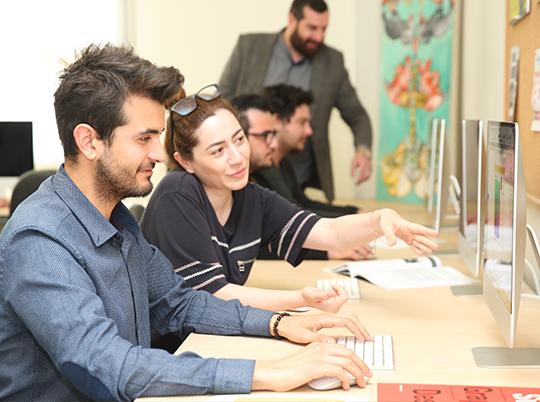


About the Program
Visual Communication Design which comprises many fields, like photography, video production, advertising design, game design, and page design emerged with the rise of the needs of the last centuries. Because of these characteristics, Visual Communication has its own unique place in the communication faculties. Visual Communication Design exceeds the limitations of graphic design and embraces a wide range of areas related to mainly communication such as TV and film production, video and image processing, 2D and 3D animation, photography, package design, and corporate identity design. Visual Communication Design education, in short, is for the students who like transferring knowledge, ideas, and dreams using photographic images, videos, and films, and who want to discover the creative potential in visual elements, and new things deeply affecting them.
Education Opportunities
The program utilizes an interdisciplinary approach using art and technology, supported by other scientific disciplines, which allow students of the department to have real work experience during their education. In addition to the theoretical courses in which the current aesthetic trends and theoretical foundations of communication are taught in mutual interaction, the department offers video production, multimedia design, 2D and 3D graphic animation, editing and generic graphics, and web design, where students will discover their own creative potential and develop them further with the expert assistance of faculty members. The courses are conducted in an international atmosphere by experienced academicians and lecturers who are experts in practice. As the program education language is English, the graduates can easily adapt to the international agencies and media organizations with the experience they have gained from the international profile of the university and the department.

Career Areas
Students who graduate from the Department of Visual Communication Design can gain the opportunity to work in many areas of the communication sector, with the interdisciplinary intellectual and creative skills they have gained and their skills to master new communication technologies. In addition, students can orient themselves towards the academic field if they wish. With the existing cooperation with media organizations, agencies and printing houses, the students of the department have the chance to gain experience in real business life during their education. Our graduates can find career opportunities in the following areas with the technological knowledge and creative skills they have acquired:
• Web Design
• Animation
• Interactive Information Design
• Computer Aided Graphic and Multimedia Design
• Advertising and Public Relations
• Video and Film Production
• Special Effects Design
• Post-Production
• Art Director or Creative Director in Advertising Agencies
• PC Software Screen Work
• Editing Suits in Local, Regional, and National TV Organizations
Accreditations
Visual Communication Design has been accredited as of June, 14 2024, by the Foundation for International Business Administration Accreditation (FIBAA), which is an institution authorized in performing external evaluations and issuing accreditation certificates.
Contact
Faculty of Communication
Çevik Uraz Center, CU124
Tel: +90 392 671 1111 Extension: 2301
Faculty E-mail: secretary-foc@ciu.edu.tr
Head of Department: Assoc. Prof. Dr. Dilan ÇİFTÇİ
Head of Department E-mail: dciftci@ciu.edu.tr
Compulsory Courses
First Semester
INTRODUCTION TO MASS COMMUNICATION
Course code
COMM101Credit
3Theoretical
3Practical
0Ects
6HISTORY OF CIVILIZATION
Course code
HIST100Credit
0Theoretical
2Practical
0Ects
2TURKISH LANGUAGE
Course code
TREG100Credit
0Theoretical
2Practical
0Ects
2TURKISH
Course code
TURK100Credit
0Theoretical
2Practical
0Ects
2BASIC DESIGN-I
Course code
VICD101Credit
4Theoretical
3Practical
2Ects
8MEDIA PERSUASION TECHNIQUES
Course code
VICD105Credit
3Theoretical
3Practical
0Ects
5VISUAL PERCEPTION AND DESIGN
Course code
VICD111Credit
3Theoretical
3Practical
0Ects
7Second Semester
PSYCHOLOGY
Course code
PSYC110Credit
3Theoretical
3Practical
0Ects
6BASIC DESIGN-II
Course code
VICD102Credit
4Theoretical
3Practical
2Ects
7HISTORY OF ART AND CULTURE
Course code
VICD106Credit
3Theoretical
3Practical
0Ects
5INTRODUCTION TO DESIGN STUDIES
Course code
VICD108Credit
3Theoretical
3Practical
0Ects
6DIGITAL MEDIA INTERFACE DESIGN
Course code
VICD110Credit
3Theoretical
2Practical
2Ects
6Third Semester
BASIC PHOTOGRAPHY
Course code
COMM231Credit
4Theoretical
3Practical
2Ects
6FREE ELECTIVE
Course code
FREEXX1Credit
3Theoretical
3Practical
0Ects
5UNIVERSITY ELECTIVE
Course code
UNIEXX1Credit
3Theoretical
3Practical
0Ects
5GRAPHIC DESIGN AND PRODUCTION
Course code
VICD215Credit
4Theoretical
2Practical
2Ects
7DRAWING AND MODELLING
Course code
VICD221Credit
4Theoretical
3Practical
2Ects
7Fourth Semester
FREE ELECTIVE
Course code
FREEXX2Credit
3Theoretical
3Practical
0Ects
5MEDIA LAW AND ETHICS
Course code
ILAW242Credit
3Theoretical
3Practical
0Ects
5UNIVERSITY ELECTIVE
Course code
UNIEXX2Credit
3Theoretical
3Practical
0Ects
5DIGITAL IMAGE PROCESSING
Course code
VICD204Credit
3Theoretical
2Practical
2Ects
7COMMERCIAL PHOTOGRAPHY
Course code
VICD210Credit
4Theoretical
3Practical
2Ects
8Fifth Semester
DIGITAL VIDEO PROCESSING
Course code
COMM403Credit
3Theoretical
2Practical
2Ects
6UNIVERSITY ELECTIVE
Course code
UNIEXX3Credit
3Theoretical
3Practical
0Ects
5SUMMER TRAINING-I
Course code
VICD200Credit
0Theoretical
0Practical
0Ects
52D ANIMATION
Course code
VICD305Credit
4Theoretical
3Practical
2Ects
5ADVERTISING DESIGN
Course code
VICD307Credit
3Theoretical
2Practical
2Ects
5AREA ELECTIVE
Course code
VICDXX1Credit
3Theoretical
3Practical
0Ects
5Sixth Semester
Research Methods for Communication
Course code
COMM366Credit
3Theoretical
3Practical
3Ects
5FREE ELECTIVE
Course code
FREEXX3Credit
3Theoretical
3Practical
0Ects
53D ANIMATION
Course code
VICD306Credit
4Theoretical
3Practical
2Ects
7BRAND IDENTITY DESIGN
Course code
VICD324Credit
2Theoretical
2Practical
2Ects
7AREA ELECTIVE
Course code
VICDXX2Credit
3Theoretical
3Practical
0Ects
5Seventh Semester
SUMMER TRAINING-II
Course code
VICD300Credit
0Theoretical
0Practical
0Ects
5GRADUATION PROJECT-I
Course code
VICD401Credit
4Theoretical
3Practical
2Ects
7ARTIFICIAL INTELLIGENCE APPLICATIONS
Course code
VICD421Credit
3Theoretical
2Practical
2Ects
7AREA ELECTIVE
Course code
VICDXX3Credit
3Theoretical
3Practical
0Ects
5AREA ELECTIVE IV
Course code
VICDXX4Credit
3Theoretical
3Practical
0Ects
5Eighth Semester
FREE ELECTIVE
Course code
FREEXX4Credit
3Theoretical
3Practical
0Ects
5GRADUATION PROJECT-II
Course code
VICD402Credit
4Theoretical
3Practical
2Ects
8ADVANCED 3D MODELLING
Course code
VICD408Credit
4Theoretical
3Practical
2Ects
8AREA ELECTIVE V
Course code
VICDXX5Credit
3Theoretical
3Practical
0Ects
5AREA ELECTIVE
Course code
VICDXX6Credit
3Theoretical
3Practical
0Ects
5Elective Courses
FILM ANALYSIS
Course code
RTVC342Credit
3Theoretical
3Practical
0Ects
3INTEGRATED MARKETING COMMUNICATION
Course code
VICD317Credit
3Theoretical
3Practical
3Ects
5DRAWING AND CLAY MODELLING
Course code
GADS103Credit
4Theoretical
3Practical
2Ects
7CREATIVITY IN ADVERTISING
Course code
PRAD324Credit
3Theoretical
2Practical
2Ects
6ADVERTISING CAMPAIGN DESIGN
Course code
VICD411Credit
3Theoretical
3Practical
0Ects
6FREEHAND DRAWING-I
Course code
VICD103Credit
3Theoretical
2Practical
2Ects
4CINEMATOGRAPHY
Course code
RTVC253Credit
3Theoretical
3Practical
0Ects
5PORTFOLIO DESIGN
Course code
VICD404Credit
3Theoretical
3Practical
0Ects
PAGE DESIGN-II
Course code
JOUR432Credit
3Theoretical
3Practical
0Ects
6POLITICAL COMMUNICATION
Course code
PRAD453Credit
3Theoretical
3Practical
0Ects
3FILM GENRES
Course code
RTVC466Credit
3Theoretical
3Practical
0Ects
5PHOTOJOURNALISM
Course code
JOUR342Credit
3Theoretical
3Practical
0Ects
5DOCUMENTARY PRODUCTION
Course code
RTVC302Credit
3Theoretical
2Practical
2Ects
5FUNDAMENTALS OF TV PRODUCTION
Course code
VICD320Credit
3Theoretical
3Practical
0Ects
6GLOBAL JOURNALISM
Course code
JOUR433Credit
3Theoretical
3Practical
0Ects
5EDITING
Course code
RTVC365Credit
3Theoretical
2Practical
2Ects
5JOURNALISM GENRES
Course code
JOUR454Credit
3Theoretical
3Practical
0Ects
5CONCEPT DEVELOPMENT
Course code
VICD415Credit
3Theoretical
3Practical
0Ects
4SOCIAL RESPONSIBILITY PROJECTS MANAGEMENT
Course code
PRAD461Credit
3Theoretical
3Practical
0Ects
5FILM PRODUCTION TECHNIQUES
Course code
RTVC353Credit
3Theoretical
2Practical
2Ects
5PUBLIC ADDRESS
Course code
COMM322Credit
3Theoretical
3Practical
3Ects
5INVESTIGATIVE REPORTING
Course code
JOUR462Credit
3Theoretical
3Practical
0Ects
5CONTEMPORARY WORLD CINEMA
Course code
RTVC431Credit
3Theoretical
3Practical
0Ects
5TV GENRES
Course code
RTVC411Credit
3Theoretical
3Practical
0Ects
5INTEGRATED MARKETING COMMUNICATION
Course code
PRAD428Credit
3Theoretical
3Practical
0Ects
5MARKETING RESEARCH IN ADVERTISING
Course code
PRAD429Credit
3Theoretical
3Practical
0Ects
5VISUAL LITERACY
Course code
RTVC467Credit
3Theoretical
3Practical
0Ects
5ONLINE JOURNALISM
Course code
JOUR456Credit
3Theoretical
3Practical
0Ects
4SOCIAL MEDIA APPLICATIONS
Course code
PRAD459Credit
3Theoretical
3Practical
0Ects
5CASE STUDIES IN MARKETING COMMUNICATION
Course code
ADPR442Credit
3Theoretical
3Practical
0Ects
PUBLIC RELATIONS CASE STUDIES
Course code
ADPR350Credit
3Theoretical
3Practical
0Ects
5JOURNALISM CASE STUDIES
Course code
JOUR450Credit
3Theoretical
3Practical
0Ects
5HISTORY OF CINEMA
Course code
RTVC361Credit
3Theoretical
3Practical
0Ects
5AESTHETICS
Course code
VICD420Credit
3Theoretical
3Practical
0Ects
4LIGHTING DESIGN
Course code
VICD410Credit
3Theoretical
2Practical
2Ects
5THEORIES OF MASS COMMUNICATION
Course code
COMM212Credit
3Theoretical
3Practical
0Ects
5WRITING FOR MASS COMMUNICATION
Course code
COMM222Credit
3Theoretical
3Practical
0Ects
5INFORMATION COMMUNICATION AND TELECONFERENCING
Course code
VICD314Credit
3Theoretical
2Practical
2Ects
3INFORMATION TECHNOLOGY AND DESIGN
Course code
VICD406Credit
3Theoretical
2Practical
2Ects
7INTRODUCTION TO CULTURAL STUDIES
Course code
COMM144Credit
3Theoretical
3Practical
0Ects
4SOCIAL MEDIA IN COMMUNICATION
Course code
COMM254Credit
3Theoretical
3Practical
0Ects
5CAMERA AND LIGHTING TECHNIQUES FOR CINEMA AND TELEVISION
Course code
RTVC214Credit
3Theoretical
2Practical
2Ects
6SKETCHING AND STORYBOARD FOR GAME DESIGNERS
Course code
GADS104Credit
3Theoretical
2Practical
2Ects
8TRNC citizens and TR citizen candidate students who have completed their entire high school education in TRNC. They are placed in undergraduate programs in line with their success in the CIU Student Placement and Scholarship Ranking Exam and the programs they prefer.
Students who are successful in the exam can register from the TRNC Marketing Office.
Applicants can directly apply online to our undergraduate programs by using the application portal. Please fill in your details correctly and upload all the required documents listed on the last page of the application form.
Required documents;
- Completed application form,
- Higher/Secondary Certificate or equivalents (e.g. O/A’Level, WAEC/NECO)
- Evidence of English Language competence: TOEFL (65 IBT) or IELTS (5.5). Students without these documents will take the CIU English proficiency exam on campus following arrival,
- Scanned copy of international passport/birth certificate,
- Fully completed and signed CIU Rules and Regulations document (which can be downloaded during the online application).
Cyprus International University provides academic scholarships for its students as an incentive for success, with most students benefiting from 50%, 75% or 100% scholarships or discounted tuition fees. Click for more information.
Tuition Fees are determined at the beginning of each academic year. Candidate students who are entitled to enroll in CIU can learn their fees in line with the Tuition Fee Calculation system.
The educational objectives of the Visual Communication Design program are as follows:
PEO1: To develop proficiency in design principles and practices, students will apply human-centered research to create brand identities, wayfinding systems, publications, packaging, interactive media, web/mobile interfaces, and data visualizations.
PEO2: To foster critical thinking and problem-solving skills, students will develop visual reasoning, organizational skills, and information theory to create visuals that effectively communicate with diverse audiences.
PEO3: To encourage interdisciplinary collaboration, students will integrate liberal arts, humanities and sciences to foster cross-disciplinary collaboration to address evolving market challenges.
PEO4: To enhance technical competence, students will master advanced computing and digital media tools to produce high-quality visual communications that meet professional standards.
PEO5: To understand historical and theoretical contexts, students will gain a deep understanding of the historical development of visual communication and its role in society.
PEO6: To prepare for professional practice, students will undertake internships, capstone projects, and portfolio development to become ready for careers in design across various sectors.
PO1: Have knowledge which is supported by up-to-date primary and secondary course books and application tools in the field of Visual Communication Design
PO2: Have the technical knowledge necessary for the field of Visual Communication Design
PO3: Have knowledge about universal human rights, social justice, quality management, environmental protection, and workplace health.
PO4: S/he visualizes imagined things in a coherent structure
PO5: S/he defines the problems related to communication and finds possible solutions for these problems.
PO6: S/he has skills to manage a project/work related to Visual Communication Design independently.
PO7: S/he develops and applies projects and activities related with his/her social environment with an awareness of social responsibility.
PO8: S/he designates and manages the requirements and processes of learning.
PO9: S/he, equipped with advanced knowledge and skills in Visual Communication Design education, who interprets and evaluates data, identifies and analyses problems and finds solutions based on research and facts.
PO10: S/he can take responsibility as an individual and a team member in complex and unforeseen problems related to Visual Communication Design projects.
PO11: S/he plans, manages and finishes media content under time restrictions.
PO12: S/he approaches advanced knowledge and skills from a critical perspective.
PO13: S/he is aware that the Visual Communication Design Department has close ties with new technological developments and also aware of the importance of pursuing these developments which have vital importance for creating new media content.
PO14: S/he is a person who informs and expresses thoughts for possible solutions related with Visual Communication Design contents prepared for related individuals and organizations.
PO15: S/he shares developments and data related to Visual Communication Design with specialists and non-specialists
PO16: S/he acts in Visual Communication Design projects in accordance with social, scientific, cultural and ethical norms.